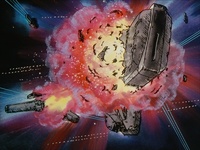User:Goldenbaum Loyalist/Sandbox
From Gineipaedia, the Legend of Galactic Heroes wiki
| Line 48: | Line 48: | ||
===Pre–Ragnarök developments=== | ===Pre–Ragnarök developments=== | ||
===Operation Ragnarök=== | ===Operation Ragnarök=== | ||
| + | ==Aftermath== | ||
Revision as of 22:33, 16 September 2016
Here I will work on writing a more detailed history for the Alliance-Imperial War article, like the major war articles on Wikipedia. Feel free to make adjustments/corrections as you see fit.
Contents[hide] |
Background
The Galactic Federation had unified humanity following a dark age and ushered in the Golden Age of Humanity, a period of two centuries that saw great advancements in science and technology, as well as extensive galactic exploration. It was challenged by the increasing problem of space piracy, but but the Galactic Federation Armada was able to defeat them, and the Federation saw many years of peace and prosperity. However, in its third century of existence, the Federation's expansion decreased drastically as the social fabric of society began to unravel. The decadence resulted in people becoming more conservative, and allowed a young, famous admiral named Rudolf von Goldenbaum to rise to power. He became a celebrity for his successes against pirates, and thus he was easily elected into the Galactic Parliament in 296 UC (3096 CE). Rudolf established the National Reform Alliance, a right wing party that pledged to restore the country's past glories, attracting young and popular politicians while gaining more and more power.
Rudolf von Goldenbaum was elected prime minister in a referendum, and later the Parliament appointed him President as well, making him the most powerful man in the galaxy. In 308 UC (3108 CE), he declared himself "president for life" and began initiating conservative reforms, which, among other things, banned free speech. Two years later, Rudolf declared himself the first kaiser, or emperor, of the Galactic Empire, establishing the Goldenbaum Dynasty. This date became known as Year 1 of the Imperial Calendar. Kaiser Rudolf spent the next decade consolidating his power while making the new Imperial government more efficient. The reforms were effective in that regard, but civil liberties essentially became non-existent under the Kaiser's monarchic and archconservative regime. He also passed the infamous Inferior Genes Exclusion Act, which resulted in the deaths of millions who were deemed to be too weak and "contaminated" the human race. Eventually, the Kaiser completely disbanded the Imperial Senate (the reformed Parliament), and the high noble elite chosen by him came to control most of the wealth and territory of the fledgling Empire.
The death of Emperor Rudolf in 351 UC (42 IC / 3151 CE) was met with celebration by many people across the Empire. However, the Imperial nobility and government were well-established by that point, and thus the democratic revolution that began was thoroughly suppressed by the Imperial Armed Forces. Rudolf's heir and grandson, Kaiser Sigismund I, aided by his father and Prime Minister, Joachim von Neue Stauffen, personally oversaw the quelling of the revolts. As a punishment, he stripped Imperial citizens of what few rights they had left, basically establishing serfdom. Emperor Sigismund's reign saw the consolidation of Imperial power and would guarantee its unquestioned position as the sole government of humanity for the next two hundred years. It was not until more than two centuries after the founding of the Empire that Arle Heinessen, a serf who was sentenced to hard labor on the ice planet Altair VII, escaped from Imperial territory with some fellow exiles.
Using a giant spaceship built of dry ice that was mined on the planet, Heinessen and his followers were able to escape from the remote world and build a fleet of eighty normal vessels. The Exodus Fleet, as it came to be known, left the Imperial-controlled Orion Arm of the galaxy through the Iserlohn Corridor, a navigable area of space that led to the unexplored Sagittarius Arm. Their leader died during the journey, but his friend Nguyen Kim Hua led the republican refugees to discovering a habitable world, which they named Heinessen, in honor of their deceased leader. There, in Year 527 of the restored Universal Calendar, Kim Hua declared the foundation of the Free Planets Alliance.
Early stages
Battle of Dagon
The Free Planets Alliance continued to grow in secret and build up its military for the inevitable clash with the Empire. The war between the Free Planets Alliance and the Galactic Empire began in 640 UC (331 IC / 3440 CE), when the Empire first learned of the existence of the the new government. Emperor of the Galactic Empire, Kaiser Friedrich III, dispatched an invasion fleet through the Iserlohn Corridor, under the command of Grand Duke Herbert. The Free Planets Alliance countered with a fleet of its own, led by Fleet Admiral Lin Pao, and the two forces clashed in the Dagon Starzone of the Iserlohn Corridor, on 14 July of that year. Contrary to the Kaiser's expectation, Lin Pao's fleet won an overwhelming victory over the Imperial Expeditionary Force, which was almost completely annihilated. Despite an early success, the Imperials lost the initiative as Grand Duke Herbert divided their force, eventually resulting in their encirclement. The fact that many of its leaders had no real combat experience and that the Imperial Fleet had been fighting in unknown territory were considered to be major factors for the Empire's defeat by later historians.
The Alliance quickly established a defensive line within the Iserlohn Corridor, and the war with the Empire soon escalated. The Imperial government unsuccessfully tried to suppress the news of the defeat at Dagon, which resulted in large numbers of refugees, dissidents, deserters, and criminal elements leaving the Empire and becoming Alliance citizens. The population and military of the FPA grew significantly during this time period, while Lin Pao and his chief of staff Yūsuf Topparol would become heroes of the Alliance in the years to come for their victory.
Post-Dagon actions
The battle situation remained at a stalemate for the next few decades, though the exact details of the war during this time period are unknown. However, the 24th kaiser of the Empire, Kornelias I, ended up launching a massive invasion of the Alliance in 668 UC (359 IC / 3468 CE). He wanted to both wipe the shame of the defeat at Dagon and to get out of the shadow of his predecessor, Maximilian Josef II, who was known for a number of internal reforms and was hailed as a great ruler. Kornelias therefore wanted to make his name in foreign policy. He sent emissaries first in an attempt to appear as a wise ruler, asking the Alliance to surrender, but they were ignored. In May 668 UC (359 IC / 3468 CE), Kornelias launched a military expedition against the FPA, leading it personally. It was only begun after making extensive preparations in order to not repeat the mistake of Friedrich III and the Battle of Dagon. During the invasion, he became known for promoting many officers to the rank of Fleet Admiral, 58 in total. Although 20 Imperial Fleet Admirals were killed in the attack, the Empire was able to beat the Alliance's counteroffensive. However, before he could completely conquer the Alliance, Kornelias was forced to withdraw due to a palace coup that occurred back on Odin, the Imperial capital. Another 15 Fleet Admirals were lost in the Alliance raids during their retreat.
The palace coup was ultimately put down, but it and the failed invasion had strained Imperial resources to the point that the Kaiser was unable to launch such an ambitious offensive again during his reign. The next known engagement did not occur until 696 UC (387 IC / 3496 CE), a battle in the Shandarua Starzone. Not much was known about this battle, other than the fact that it was an Alliance victory and was considered to be a shameful defeat for the Empire as late as 795 UC (486 IC / 3595 CE).
Establishment of Fezzan
At some point, a second navigable route between the Galactic Empire and the Free Planets Alliance was discovered: the Fezzan Corridor. A merchant from Terra, Leopold Laap, petitioned the Imperial government with a strong passion for the autonomy of Fezzan as a special region of the Empire. As a result, in 682 UC (373 IC / 3482 CE), the Dominion of Fezzan was established as an autonomous domain of the Empire which nominally pledged loyalty to the Imperial crown, though in reality it had great control over its own policies. It was even given tacit permission to establish relations with the Alliance, with both of the other powers maintaining their own high commissioner's offices on the planet, which carried out diplomatic functions. Fezzan became an quasi-independent state, becoming a center for three-way trade, as well as allowing diplomacy and espionage to exist between the two nations. Laap served as the first Landesherr, or feudal lord, of Fezzan.
The Dominion possessed only a small fleet of patrol ships, instead relying on immense economic strength and political maneuvering to maintain its position. It became an economic superpower by 796 UC (487 IC / 3596 CE) and essentially controlled all trade in both the Empire and Alliance, while also maintaining considerable influence in underground criminal cirlces. It had been a mystery how Fezzan had become so successful economically in a short amount of time, and the true reason did not become known until after the end of the Alliance–Imperial War: it had actually been founded on the initiative of the Terraist Church, a religious cult that sought to restore Earth as the center of humanity. The Church had used the vast wealth that had been hoarded by the United Earth Government during the Earth–Sirius War to fund the project.
The Terraists then allowed Fezzan to become powerful in order to use it to manipulate events from behind the scenes, preventing the Empire and Alliance from making peace and preparing for the Church's eventual takeover. It was for this reason that Fezzan was believed to have organized the murder of the 27th kaiser of the Galactic Empire, Manfred II. He narrowly avoided assassination in his youth and fled to the Free Planets Alliance, where he was raised in more liberal environment. Manfred intended to make peace upon returning to the Empire and taking the throne in 707 UC (398 IC / 3507 CE), but lasted less than a year before being assassinated, unable to carry out his plan. Reactionary nobles seemed to be responsible on the surface, but it was rumored that Fezzan was behind the killing.
Middle stages
Rise of the 730 Mafia
The events of the first couple of decades of the new century, other than the Manfred II assassination (708 UC (399 IC / 3508 CE)) and an uprising of Imperial troops under the command of Vice Admiral Telemann (717 UC (408 IC / 3517 CE)), are largely unknown. However, the time period between 730 UC (421 IC / 3530 CE) and 745 UC (436 IC / 3545 CE) would be defined by the actions of a small group of brilliant officers in the Alliance Star Fleet: the Year 730 Mafia, named for the fact that they all graduated in that year from the Free Planets Alliance Officer Academy. The group was led by Bruce Ashbey, who came to be considered as a genius tactician, and also included Frederick Jasper, Wallace Warwick, John Drinker Cope, Vittorio di Bertini, Fang Tchewling, and Alfred Rosas. Not much is known about the first eight years of the Mafia's existence, other than the fact that they trailed each other from assignment to assignment and were led by Ashbey, who was a captain, while the others held the rank of commander. They rose to prominence in 738 UC (429 IC / 3538 CE), after defeating the Empire at the Battle of Firezard, at which point they started to become famous among the Alliance general public for their exploits.
The 730 Mafia's talents and achievements attracted the attention of an Imperial defector, Admiral Martin Otto von Siegmeister, a republican idealist who became disillusioned after witnessing the flaws in the Alliance political system. He viewed the members of the 730 Mafia as his chance to bring about changes that he wanted to see. It was theorized decades later that Seigmeister used his intelligence network in the Empire to supply Ashbey with information, which he used in battles. The next several years saw the rise of the Mafia, in both their rank and popularity. Commodore Asheby was promoted to rear admiral, and then vice admiral, being given command of one of the Alliance's numbered fleets at a young age. The other members were promoted as well, but remained one rank behind Ashbey. The man's arrogant attitude and his taking of the credit for their successes caused some resentment from the others, but the group worked together well for the most part. It was also during that time that Ashbey proposed a strategic plan for building a fortress at the Alliance end of the Iserlohn Corridor, to prevent Imperial invasions and strengthen defense. However, another project was also proposed at the time, a tactically-minded one: the enlargement of the Star Fleet. Both were costly and thus only one could be implemented. Ashbey's friend and chief of staff, Alfred Rosas, later theorized that Ashbey picked the fleet over the fortress, despite the latter being more useful over the long run, because he was a tactician rather than a strategist.
Second Battle of Tiamat

By 745 UC (436 IC / 3545 CE), Ashbey had become a full admiral and was the Chief Commander of the Space Fleet, while his friend Rosas was the Space Fleet Chief of Staff. The others each commanded one of the Alliance's numbered fleets, and together, the 730 Mafia had reached its peak in popularity and the authority it possessed in the military. That year, Ashbey responded to an Imperial build-up of forces in the Tiamat Starzone by deploying about half of the Star Fleet there. The battle that would unfold there became the largest in the history of the war up until that point, with more than a hundred thousand ships and ten million soldiers taking part. The Imperial Forces were led by their Chief Fleet Commander himself, Fleet Admiral Zeiten.




